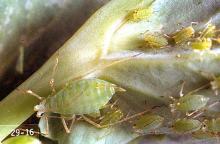Includes
Clover aphid (Nearctaphis bakeri)
Pea aphid (Acyrthosiphon pisum)
Pest description and crop damage Small aphids, light green or pinkish green, which secrete a sticky honeydew that cakes the seed head. They attack red clover, alsike clover, and white clover. The clover aphid, N. bakeri, significantly reduces red clover seed yields in western Oregon if not controlled early in the season. A hay or silage crop is usually taken in mid-May to early June; begin inspecting the regrowth about 2 to 3 weeks later. Look between the leaf stipules and the stem, which is where this aphid initially begins to accumulate. When at least half the stems show signs of aphids-this is usually well before bloom-apply insecticide. Bloom and postbloom treatments do little to prevent honeydew problems or increase seed yield.
Management-chemical control
- bifenthrin (Batallion 2EC, Brigade 2EC, Discipline 2EC) at 0.06 to 0.1 lb ai/A. REI 12 hr. Do not apply to blooming crop or allow to drift while bees actively visit bloom. Do not make more than 3 applications per crop year. Allow at least 21 days between treatments. Do not graze clover after applying. Do not cut treated clover for hay or forage. Do not use harvested seed for sprouting. No part of the treated field, including seed, seed screenings, hay, forage, or stubble, may be used for human or animal feed. Processed seed must be labeled. 24c SLN: Batallion 2EC, OR-200006 (expires 12/31/2025), Brigade 2EC, OR-070013 (expires 12/31/28), ID-070009 (expires 12/31/26); Discipline 2EC, OR-040039 (expires 12/31/2025) and ID-040009 (expires 12/31/24). Oregon and Idaho only. Group 3A
- flonicamid (Beleaf 50 SG) at 0.088 lb ai/A. REI 12 hr. PHI 60 days. Apply before aphid populations begin to build and before crop damage is evident. Do not apply more than two applications per year. Do not apply more than 0.18 lb ai/A per crop year. Do not allow foraging of fields or harvesting for hay within 60 days of the last application. Group 29.


